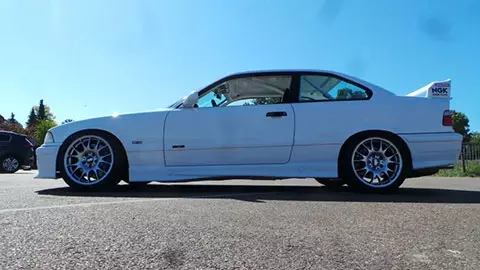The expanding universe of SimRacing

The roots of SimRacing
SimRacing is a type of racing game software that aims to accurately replicate real-life motor racing. Competitors must deal with real-world variables such as fuel usage, tyre wear, suspension settings as well as grip. Furthermore, aspects of traditional motorsport such as threshold braking, maintaining control with reducing tyre traction, and entering/exiting turns at high speed, set SimRacing apart from other types of virtual racing games.
It can trace its roots back to the early 1980s arcade scene and the Formula 1 racing game ‘Pole Position’ in particular – widely regarded as the one of the most influential video games of all time. Played within an arcade cabinet, Pole Position featured computer-generated competitors, crashes, qualifying laps and also pioneered the third-person rear view perspective now dominant in racing video games.
The 1990s witnessed the beginning of the divergence between arcade and home gaming. With the launch of classic games consoles like the Super Nintendo, the Sega Mega Drive and the Sony PlayStation, gamers were now able to hone their skills in the comfort of their own homes. This decade, in general, experienced a surge in technological innovation and the gaming industry was no different. Iconic games – like Indianapolis 500: The Simulation (1990), Formula One Grand Prix (1992), NASCAR Racing (1994) and the genre defining Gran Turismo (1997) – were released throughout the decade, with each delivering a more realistic racing experience.
The rise of Esports
With the dawn of broadband internet as well as increased technological advances in terms of graphics and gameplay, the phenomenon of community gaming has become increasingly popular in the last two decades. Within this genre resides ‘Esports’ (electronic sports), a section of the video game industry where players compete in different video games (either remotely or at in person events) to achieve world rankings and win prize money. “Although SimRacing is relatively small when compared to other forms of Esports, prize money can range from a few hundred euro to several thousands. There have also been SimRacing events with prize money of over €1 million,” says Lucas Müller of the Dörr Esports team – which belongs to the traditional racing team, Dörr Motorsport.
With competitors sitting in front of a screen and the lack of any real cardio/physical demands, controversy exists regarding whether or not Esports constitute real sport. In this debate, however, SimRacing stands out from the crowd due to the skills required to compete at the top level. In fact, it has become so realistic in terms of graphics, vibrations, braking, accelerating, steering etc. that a gamer who has never driven a real car would be able to properly drive a race car on a real-life track.
Fascinatingly, many SimRacers have actually made the jump from the virtual world to the real world of racing. These, among, many others include Tim Heinemann (GER), Lucas Ordóñez (ESP), Laurin Heinrich (GER) and Marc Gassner (GER).
Today, many professional Formula 1 drivers incorporate SimRacing into their practice routines, while teams such as McLaren are investing heavily in it.
Getting involved
Another benefit of SimRacing is that it has helped to bridge the gap between the haves and the have nots. Whereas motor racing is a sport where one requires a lot of financial backing from a very early age in order to make it, anybody with an internet connection and some basic equipment can learn how to race and compete.
“To race, all you need is a normal gaming steering wheel and pedals (e.g. Logitech G29), and a simulation game. These include iRacing, F1, Assetto Corsa, rFactor2, RaceRoom, GT7, Forza Motorsport, WRC, Automobilista 2 and some more,” says Leo Krippner of the Dörr Sports racing team.
In terms of space, not much room is needed for lower range equipment. “You can simply place the steering wheel on a desk,” informs Lucas. “Extra space, however, is needed for high-end simulators. About 2m x 1.50m.” Other common accessories include racing gloves and shoes. “Shoes to make it easier to step on any pedals with more resistance and gloves help to avoid wearing out the steering wheel too much. Both, however, are not necessary to have,” he tells.
The prices of SimRacing equipment range from affordable to very expensive. “You can compete with equipment costing around €250 but high-end SimRacing gear can cost €8,000 and more,” says Leo. A lack of money, however, does not negatively impact performance too much. “You can be very fast with inexpensive equipment. Naturally, expensive equipment is more comfortable to use in terms of feel, braking and overall enjoyment but you can also reach the ultimate lap time with basic equipment.”
On the track
The continuing growth and success of SimRacing is an intriguing example of art imitating life. “Just like in real motorsport, there are now lots of teams such as Team Redline, Williams Esports, BS+ Competition, Apex Racing Team and our own Dörr Esports,” says Lucas. “Almost everything present in real racing, such as teams, drivers, racetracks, race stewards and race directors (who monitor the race and impose penalties when necessary) are also present in SimRacing.”
Strategy is also a very important factor, with teams – when permitted – often performing detailed plans before the race. “We go through different scenarios for pit stops, for example, and we consult engineers who possess tools and knowledge from real motorsport for long-distance races,” says Lucas.
Everything, however, is liable to change once the race gets going and the members of Dörr Esports are well-drilled to always expect the unexpected. “Like any sport, communication is vital, and drivers are able to talk to each other and other team members via Discord/Teamspeak to develop the best plan of action during the heat of the race.”
In the space of four decades, SimRacing has evolved into something unbelievably similar to the real thing. It will indeed be interesting to see what it looks like in another 40 years.
 Niterra Blogs
Niterra Blogs








